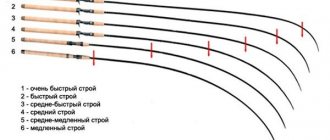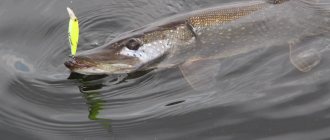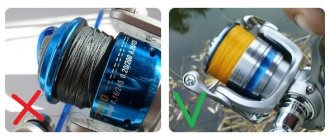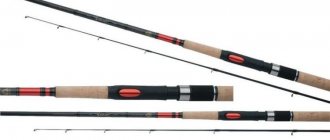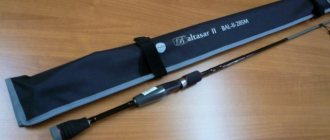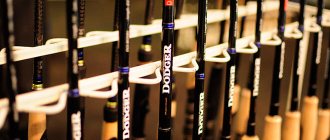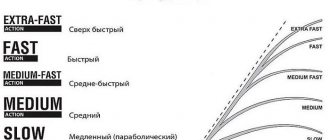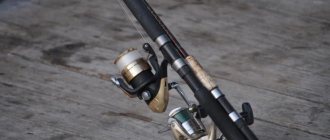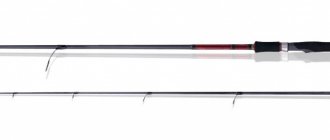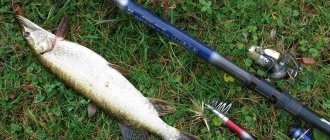The fast British dance jig gained enormous popularity in Western Europe and the New World in the 17th century. Expressive body movements did not pass the attention of fishermen, serving as the source of the name for one of the most effective types of predator fishing. In order to effectively catch perch, catfish, pike, and pike perch at a distance, it is important to choose the right spinning rod for shore jig with parameters that match the fishing conditions and the type of fish. You must be able to use various types of baits and baits, including near the surface of the water.
Features of jig fishing
Seasonal or weather changes in the behavior of predatory inhabitants of rivers, lakes, ponds and reservoirs force fishermen to constantly search for catching equipment. In this regard, the exception is the coastal jig, which allows you to use a huge range of baits of various weights, colors and shapes without replacing the spinning rod. This type of fishing is characterized by a wide variety of movements: stepped, pendulum, uniform, dotted, etc. By changing the speed of the reel and the weight of the jig head, you can successfully actively search for predators, alternately fishing the bottom, middle and upper layers of the reservoir.
To ensure that the bait request is always accurate and the hooking is as reliable as possible, the stick for jig fishing from the shore must be ideal in size, test and structure.
Spinning rod length
The size of the reservoir and strong current are the key factors in selecting the height of the rod. Regular shore jig on narrow rivers 10-20 meters wide requires the shortest forms of 1.8-2.1 m. In addition, they are very convenient when catching a predator from a boat, wade, from a dam or bridge. Large rivers and lakes dictate different requirements for jig spinning, which must deliver bait over a distance of 70-100 meters. To perform a fast power swing, you will need a rod 2.4-4.0 m long.
To learn more:
Advantages of silicone predator baits
Sticks for jig fishing with a height of 2.4-2.7 m are universal, which provide:
- possibility of short and long casts;
- high-quality wiring management;
- precise bite control;
- catchy hooking;
- Smooth fishing.
This is the kind of tackle that is optimal for a beginner and fishing in an unfamiliar body of water.
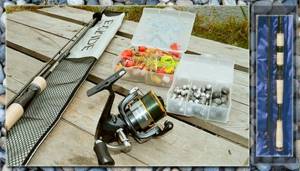
And now about what the predator tries to taste, that is, about the bait
Which bait is more suitable for this fishing method than others? It is not difficult to justify the choice. When deep fishing with a spinning rod from the shore, there are fewer alternative choices than when fishing from a boat, since the prevailing requirement in the first case is casting range. Many years of improvement of this method of fishing, an uncompromising struggle for casting range, brought forward a simple bait - a small rotating spinner “Master”, connected to a sinker head using a winding ring. The advantages of this bait are many:
due to low aerodynamic resistance, it flies very far, up to 80 m and beyond; it launches independently in the water, that is, it begins to rotate without additional jerks, only under the weight of the sinker-head descending on the fishing line;
works great in still water and on any current due to the correctly selected petal shape; works well with step-by-step wiring, since during the free fall of the sinker-head, the connecting ring allows the spoon to rotate relative to it at any angle, that is, towards the oncoming flow of water; durable, resistant in the teeth of a predator, only scratches and pinpoint dents remain on the petal from its fangs; thanks to the asymmetrical sinker, it does not twist the line; thanks to the sinker-head and leash, it does not get overwhelmed when casting, even in a headwind; the presence of the sinker-head allows you to “probe” the bottom topography and discover the most attractive places for a predator; simple in design, easy to make yourself if you have the necessary materials and skills. Having the described gear and having the fishing skills, it is almost impossible to remain without a catch when fishing in a deep-sea reservoir. It is easier for a novice fisherman to master this method of fishing in standing reservoirs or in sections of rivers with a slow flow. It is easier to cast long distances with a spinning reel than with an inertial reel. You can also adapt to casting baits of different weights quite quickly. And step wiring is not difficult to master. But in order to learn to sense the slightest nuances in the work of the bait, “probe” the bottom with it, mentally draw a spatial picture of the underwater relief and determine the location of the predator, you will need practice. However, practice is also a gainful thing, if you have the desire.
Rod build
An important criterion for the effectiveness of a spinning rod for shore jigging is its behavior under load. The accuracy and distance of the cast, the controllability of the retrieve, and the quality of the hook depend on how quickly and strongly the form is bent. The main types of rod action are presented in the table (according to the maximum possible result).
| Name/labeling | Bend degree | Feels. bites | Cutting quality | Casting distance | Casting accuracy | Control and smoothness of the bait |
| Very fast (Extra Fast, EE) | just the tip | 100% | 100% | 80% | 50% | 10-20% |
| Fast (F) | 1/3 | 90% | 90% | 80% | 80% | 30-40% |
| Medium (Medium, Moderate, M) | 1/2 (half parabola) | 80% | 80% | 90% | 80% | 70% |
| Slow (S) | along the entire length (parabola) | 60% | 60% | 100% | 60% | 100% |
Special attention should be paid to blanks with an intermediate medium-fast action (Medium-Fast, MF), which bend in the range from 1/3 to 1/2 of their upper part and combine good characteristics of accuracy and casting range and controllability of the retrieve.
Very fast spinning rods do not cope well with the task of catching large pike and pike perch, and even more so catfish; their purpose is to catch a predator weighing 0.2-3 kg. When catching strong and heavy fish, it is better to give preference to a medium or slow blank.

Spinning rod marking
Jig fishing
It is considered the easiest way to catch predatory individuals. Does not require the purchase and assembly of expensive equipment. Among the features of jig fishing:
- Often this is shore fishing. This method is used to fish coastal dumps, places under snags, and coastal holes. With such equipment, you can also engage in bottom capture of predators.
- Fishing objects: pike, ide, perch, chub, asp, pike perch.
- The standard length of a jig spinning rod is from 2.5 to 3 m.
- Build – fast or very fast. So that the play of the bait and the bite can be clearly seen by the movement of the tip of the tackle.
- It has good flight properties, making it possible to get a tricky trophy even from great depths.
When assembling the rig, you need to carefully consider what type of braid to use. The weight of the sinker depends on the thickness, and the quality of the material determines the performance of the equipment. The versatility of the jig lies in the fact that you can catch perch and pike with large baits with a small sinker in shallow water and high vegetation.
There are several types of jig rigs:
- dropshot;
- Caroline;
- tokyo rig;
- Texas;
- jig-rig;
- diverter leash and others.
To increase the casting distance, it is recommended to take a rod with a fast, medium, or very fast action. With a jig rig, it will be possible to fish without problems in shallow water, overgrown banks, and reservoirs with strong currents.
Shore jig stick test
A bait that is too heavy, combined with a weak blank and a strong cast, is the main cause of serious equipment failure. And vice versa, a powerful rod equipped with a light spinner of several grams will not allow you to feel it normally during retrieving and quickly respond to bites from a predator. To avoid this, it is necessary to take into account the factory test of the spinning rod for jig, which indicates both permissible weight limits for the bait. Based on this principle, it is customary to distinguish the following classes of fishing rods:
- ultra-light (Ultra-Light, UL) – 0-5 g;
- light (Light, L) – 3-15 g;
- medium-light (Medium-Light, ML) – 5-20 g;
- medium (Medium, M) – 7-30 g;
- medium-heavy (MH) – 10-45 g.
To learn more:
Differences between a split shot and a drop shot
Heavy tackle (Heavy, H) with a test weight of 20-80 g is also used, which is the longest-range among jig spinning rods.
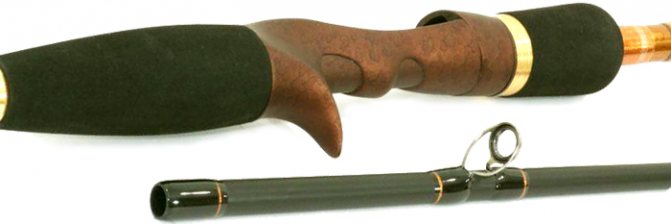
Ultralight and lightweight classes work optimally for perch. For pike, medium-light or medium tackle with a test weight of 10-30 g is suitable. When fishing for pike perch, it is better to use medium and medium-heavy rods with a test weight of 10-50 g.
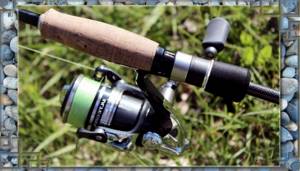
How the speed of bait movement affects fishing performance
Now about the wiring speed. Which wiring is better: continuous or intermittent? Here the choice should directly depend on the activity of the intended production.
If there is a need to fish as large an area of a reservoir as possible in a relatively short time, then the wiring should be uniform.

Uneven wiring for classic spinners does not represent a complete stop of movement, but a slowdown or acceleration of the speed of movement of the bait.
The greatest skill is retrieving the blade, when we stop the movement of a slowly moving spoon, forcing it to practically stand still, and then “wind it up” again.
Thus, you can tempt the laziest and well-fed perch to bite. However, this method will require a very high-quality rod made of high-modulus graphite and a reliable reel.
This is necessary in order to feel the very moment of the petal being torn off and the spinner being inserted. Of course, this method of wiring is the slowest possible, so it can only be used when there is no bite and in a place where the presence of fish is guaranteed.
In the case when the river perch follows the bait, but does not attack it, you can try to move the spoon at normal speed, making a sharp jerk with the tip of the rod every few turns of the reel. This may provoke a predator.
But still, the best thing would be not to select your own wiring option for each specific bait, but to replace the bait itself, and not even one spinner with another, but instead of a spinner, use, for example, a spinner or colored silicone.
Usually, if you are not going to change the bait, only retrieving the blade can radically change the fishing performance.
Form material
Heavy and uncomfortable aluminum poles are irrevocably a thing of the past. Manufacturers are increasingly abandoning the usual telescopic design, giving preference to more reliable plug connections. The main characteristics of the materials used to make modern shore jigging rods are presented in the table.
| Material/marking | Advantages | Flaws | Price |
| Fiberglass (fiberglass, FB) | Strength, good flexibility, ease of use, wear resistance | Heavy weight, decreased sensitivity | Low |
| Carbon fiber (GRAPHITE, CARBON) | Strength, lightness, high sensitivity, rigidity (depending on the graphite content, marked on the form with the IM index) | Instability to impacts and compression | High |
| Composite (carbon fiber + fiberglass) | High rigidity and strength, moderate weight, excellent throwing properties and fragility | Fragility | Average |
| Kevlar (Kevlar, carbon fiber + para-aramid fiber reinforcement) | Increased fatigue and mechanical strength, flexibility, sensitivity | Instability to transverse deformation by compression | High |
There are no completely Kevlar blanks. This material most often serves as a reinforcing braid for carbon, which is prone to brittleness.
The best spinning rod models for jig fishing from the shore
Shore jig fishing requires rods that combine long range, high sensitivity and high-quality hooking of predatory fish with any line length. That is why fishing tackle manufacturers offer not only universal, but also specialized lines of spinning rods for jigging. The names and main characteristics of the most popular fishing rods are given in the table.
| Model | Length, m | Build | Bait test, g | Peculiarities |
| Norstream Kando 902MH | 2,74 | Fast | 12–38 | Overload resistance |
| Major Craft Rizer 832MH | 2,52 | Fast | 8-35 | High sensitivity |
| Banax Thunder 90MXF2 | 2,74 | Medium-fast | 7-25 | The best budget spinning rod for long-range jigging |
| Pontoon21 Psychogun 912MMHSF | 2,74 | Fast | 10-32 | Effective use of the entire length of the blank due to the special arrangement of the rings |
| Daiko Ultimatum 962HMF | 2,89 | Medium-fast | 12-60 | Casting over 100 meters |
| Norstream Spiker 782MH | 2,34 | Fast | 10-35 | Forced fishing of a predator in snags, suitable for fishing from the shore and boat. |
Find out more:
Catching chub in October with a spinning rod
In addition to throwing qualities and high sensitivity, a spinning rod for shore jigging should be as ergonomic as possible and not tire the angler. The most popular gear is made from various modifications of light carbon fiber and has a light weight of 110-150 g. It is this criterion that is best to focus on when buying a jig rod for fishing from the shore, regardless of the type and size of the reservoir.
